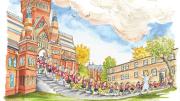1906
The Newsboys Union of Boston raises $2,567.17 toward a scholarship fund that will send former newsboys to Harvard.
1931
President Conant decides that the football team shall play a postseason game, the receipts of which will go to unemployment relief.
1941
The Harvard Crimson drops its isolationist stand as the academic year begins. “That not only the Crimson but even the Leftist Student Union now find an isolationist position untenable is a sober comment on the state of mind of the undergraduates who returned to College this fall,” the Bulletin comments.
1946
Fletcher P. Martin, a city editor and war correspondent at the Louisville (Kentucky) Defender, becomes the first Nieman Fellow of color. He is one of 14 fellows chosen from a pool of more than 100 applicants, and is also the first representative of the Negro press.
1956
The Crimson discontinues its annual “Miss Radcliffe” beauty contest due to Radcliffe pressure, much to the dismay of Bulletin editors, who mourn: “For the undergraduate who had to contend with…the harsh fact that the myth of the Radcliffe Plain Jane has a broad base in reality, it was nice to be able to look to the symbol of an idealized Radcliffe populated with angels.”
1971
After a summer’s trial run, Harvard’s first day-care center moves from the basement of Memorial Hall to a permanent location in the former ROTC building near the Divinity School. The center has 24 children, and a waiting list of 19. Two Radcliffe day-care centers are already in operation.
* * *
Late-breaking news: A survey carried out during the twenty-fifth reunion of the class of ’46 revealed that 76.2 percent would object to a son’s becoming a hippie, and 48 percent opposed the women’s liberation movement, but 96.8 percent were in favor of birth-control devices.









